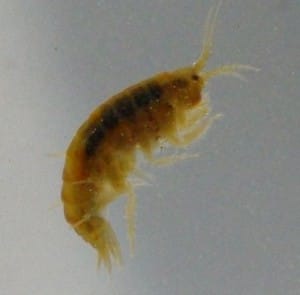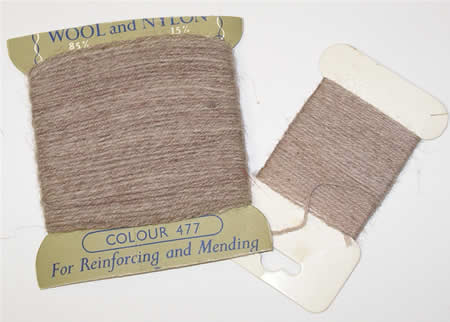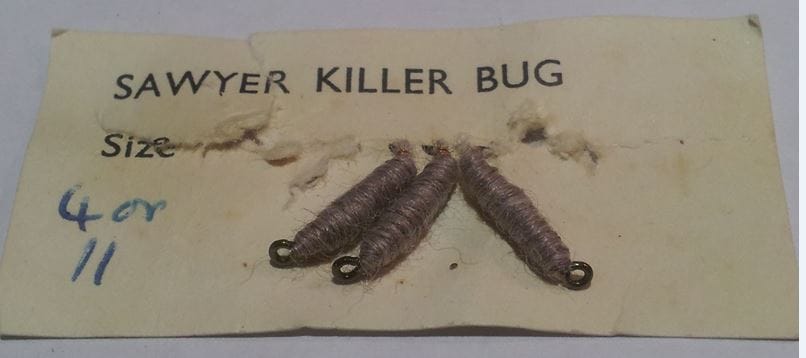Not so long ago grayling (Thymallus thymallus) were considered by most keepers in the chalkstream valleys to be vermin number two closely behind pike in the monoculture of trout that existed at the time. Many methods of eradication were employed including netting and electrofishing. I remember as a child seeing piles of dead and dying fish every few hundred yards below my parent’s house in Amesbury on the river Avon. Frank Sawyer (who devised the pheasant tail nymph, one of the most successful flies world-wide) also created the Killer Bug to represent the graylings favourite food item in the chalkstreams the freshwater shrimp, Gammarus Pulex.
 Like the PT nymph the Killer Bug is tied very simply and must be one of the easiest “flies” to tie. An underbody of copper armature wire covered with a grey wool. The wool though is something special, Chadwicks 477, original use was for darning socks. Long out of production cards of the wool change hands at auction in excess of £50. Although I do have a couple of original cards I have found a reasonable substitute from Lureflash. The wool has a characteristic of turning slightly pink when wet, now a known trigger colour for grayling.
Like the PT nymph the Killer Bug is tied very simply and must be one of the easiest “flies” to tie. An underbody of copper armature wire covered with a grey wool. The wool though is something special, Chadwicks 477, original use was for darning socks. Long out of production cards of the wool change hands at auction in excess of £50. Although I do have a couple of original cards I have found a reasonable substitute from Lureflash. The wool has a characteristic of turning slightly pink when wet, now a known trigger colour for grayling.
 I recently came across a slip of paper with 3 remaining original Killer bugs tied by Frank’s wife Margaret and were sold in 10s rather than dozens. I guess my late father bought these as some time back in the 1970s. Obviously he or I used a few. Look at the old hook sizing marked in ink on the paper slip.
I recently came across a slip of paper with 3 remaining original Killer bugs tied by Frank’s wife Margaret and were sold in 10s rather than dozens. I guess my late father bought these as some time back in the 1970s. Obviously he or I used a few. Look at the old hook sizing marked in ink on the paper slip.
Thank goodness Frank never succeeded in eradicating the grayling but it was fascinating to see him working a shoal using his famous induced take method on my visits up to Netheravon.
Frank’s theory was that by the removal of these fish his trout would have far less competition for the available food source and consequently grow bigge, an angler when stalking a trout would then not be bothered by small grayling spooking the intended quarry.
Despite all efforts of elimination the grayling populations remain extremely healthy in all of our streams and rivers and are an indication of good water quality.
When small these fish readily take a surface dry fly, but as they grow older and become bigger they become less inclined towards so doing. All the really big fish tend to be caught on deep sunk nymphs. When young, grayling are very gregarious and shoal in the shallower waters but become more solitary with age.
A salmonid, but classified as a coarse fish, the grayling season runs from June 16th through to March 17th. On the chalkstreams they are usually only targeted from October through to the end of December. Most river keepers and fishery managers then stop the fishing so as not to disturb our brown trout which are then starting to spawn. In my opinion this is a very good policy as it also gives the fishery a rest and allows banks to repair from the footfall incurred since the start of the trout season back in April or early May.
To many, the pursuit of this totally wild fish has become an obsession and not just a means of extending the fly fishing season beyond the close of the trout season.
If you would like to target the “Lady of the Stream” then we can offer various beats offering excellent opportunities to fish into the autumn and early winter months.
River Avon, Heale Estate Broads Beat
Available from 16th October to 31st December
½ mile single bank fishing on one of the best grayling beats of the Hampshire Avon.
River Anton Goodworth Clatford
Available from 1st November to 31st December
1 ¾ miles of single and double bank fishing producing many fish over 2lb and some close to 3lb.
River Test
Various estate beats on upper, middle and lower river from Broadlands to Longparish.
River Test & Anton combination days.
AardvarkMcleod have exclusive access to the Cottonworth Estate on Saturday 22nd & Sunday 23rd October. On these days it will be possible to fish both rivers each day something that is not usually available. The Anton as above at Goodworth Clatford produces some very large fish and a 2lb fish is common whereas the Test beats produce larger quantities of slightly smaller fish.
River Kennet
2 ½ miles of main river and carrier east of Hungerford, max 6 rods per day and fish to 2lb plus.
River Lambourn
1 ½ miles at Welford Park, grayling up to 3 ¾ lbs November and December only.
Limited availability, fishing includes the services of local guide.
Our expert grayling guides can be booked in addition to any fishing if required.
If you would like more information on any of our chalkstream grayling fishing please contact Alex Jardine or call our office on +44(0)1980 847389.


